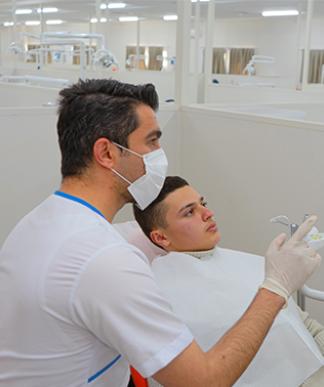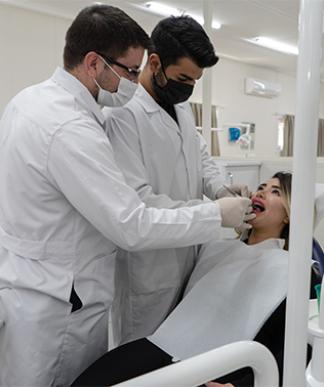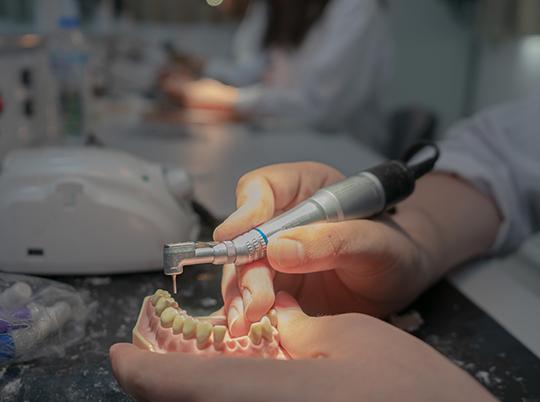


About the Program
The doctoral program of the Department of Orthodontics offered by the Institute of Graduate Studies and Research at Cyprus International University aims to train qualified orthodontist specialists and dentists, who examine the disorders and irregularities in the jaw and face region and prepares a treatment plan, is qualified in the field, has contemporary, analytical and critical thinking using the most up-to-date information and technologies.
Education Opportunities
Orthodontics doctoral program education includes the skeletal structures of the jaws, patient diagnosis, and treatment, knowledge, skills, and attitudes in dental alignment.

Career Areas
Graduates of the orthodontics doctorate program can continue their professional life as an academic with the title of "Doctor of Science" or can work as a dentist in public or private health institutions.
Contact
Institute of Graduate Studies and Research
Graduate Sciences and Education Center, GE106
Tel: +90 392 671 1111 Extension: 2776
Institute E-mail: ciu-institute@ciu.edu.tr
Compulsory Courses
First Semester
REMOVABLE AND FUNCTIONAL APPLIANCES
Course code
ORTO601Credit
4Theoretical
4Practical
2Ects
6CEPHALOMETRIC ANALYSIS, RECORDS AND DIAGNOSIS
Course code
ORTO603Credit
4Theoretical
4Practical
2Ects
6BIOLOGICAL BASIS OF TOOTH MOVEMENT
Course code
ORTO605Credit
3Theoretical
2Practical
2Ects
4CLINICAL APPLICATIONS-I
Course code
ORTO701Credit
0Theoretical
0Practical
0Ects
10DENTOFACIAL GROWTH AND DEVELOPMENT
Course code
ORTO703Credit
3Theoretical
3Practical
0Ects
4Second Semester
PREVENTIVE AND INTERCEPTIVE ORTHODONTIC TREATMENTS
Course code
ORTO602Credit
4Theoretical
2Practical
4Ects
6FIXED ORTHODONTIC APPLIANCES -I
Course code
ORTO604Credit
4Theoretical
2Practical
4Ects
6TEMPORARY ANCHORAGE DEVICES
Course code
ORTO606Credit
3Theoretical
2Practical
2Ects
4CLINICAL APPLICATIONS-II
Course code
ORTO702Credit
0Theoretical
0Practical
0Ects
10MALOCCLUSIONS AND TREATMENT PRINCIPLES
Course code
ORTO704Credit
3Theoretical
3Practical
0Ects
4Third Semester
FIXED ORTHODONTIC APPLIANCES -II
Course code
ORTO607Credit
4Theoretical
2Practical
4Ects
6RETENTION, STABILITY AND COMPLICATIONS
Course code
ORTO609Credit
4Theoretical
2Practical
4Ects
6SEMINAR
Course code
ORTO611Credit
0Theoretical
0Practical
0Ects
5CLINICAL APPLICATIONS-III
Course code
ORTO705Credit
0Theoretical
0Practical
0Ects
10CLINICAL RESEARCH TECHNIQUES AND ETHICS
Course code
ORTO707Credit
2Theoretical
2Practical
0Ects
3Fourth Semester
DOCTORAL PROFICIENCY
Course code
ORTO608Credit
0Theoretical
0Practical
0Ects
20CLINICAL APPLICATIONS-IV
Course code
ORTO706Credit
0Theoretical
0Practical
0Ects
10Fifth Semester
THESIS STUDY
Course code
ORTO610Credit
0Theoretical
0Practical
0Ects
120CLINICAL STUDY IN DOCTORAL FIELD-I
Course code
ORTO612Credit
0Theoretical
0Practical
0Ects
0Sixth Semester
CLINICAL STUDY IN DOCTORAL FIELD-II
Course code
ORTO613Credit
0Theoretical
0Practical
0Ects
0Seventh Semester
CLINICAL STUDY IN DOCTORAL FIELD-III
Course code
ORTO614Credit
0Theoretical
0Practical
0Ects
0Eighth Semester
CLINICAL STUDY IN DOCTORAL FIELD-III
Course code
ORTO615Credit
0Theoretical
0Practical
0Ects
0Elective Courses
Entry Requirements
- The prospective student agrees that she/he shall apply to YÖK or YÖDAK for the equivalency of their undergraduate diplomas.
- The prospective student agrees that she/he shall apply to the Association of Turkish Cypriot Doctors in order to become a temporary member.
- The prospective international student agrees that she/he shall provide a Turkish Language Certificate or shall attend the Turkish Proficiency Test or shall study for a year for Turkish language education in order to continue their clinical studies. During their Turkish language study, students shall take one PhD course per semester for their PhD in Dentistry program.
- Prospective students agree that she/he shall provide an English Language Certificate (IELTS 6.0) or shall attend the English Proficiency Test which is organized by the School of Modern Languages. According to their success, students shall continue to the first year of the program or shall study the English language.
- Prospective students agree that she/he shall accept to work at least 20 hours per week during their PhD study and this clinical duty shall continue for 46 weeks per year.
- Prospective students agree that she/he shall accept buying clinical dentistry units with a written commitment.
- Surgery prospective students agree that she/he shall accept to comply with a two-semester (9 months) rotation duty in a full-fledged hospital.
- If necessary, Prospective students agree that she/he shall attend an online interview about the basic dental knowledge of the relevant field.
- Prospective students agree that she/he shall comply with clinical working programs with a written commitment.
- Prospective students agree that she/he shall comply with a written commitment to obeying professional and ethical responsibilities not to cause malpractice conditions.
Cyprus International University provides academic scholarships for its students as an incentive for success, with most students benefiting from 50%, 75% or 100% scholarships or discounted tuition fees. Click for more information.
Tuition Fees are determined at the beginning of each academic year. Candidate students who are entitled to enroll in CIU can learn their fees in line with the Tuition Fee Calculation system.